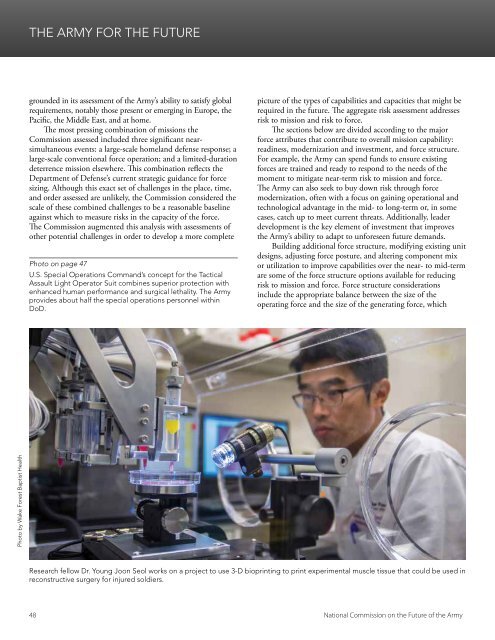THE FUTURE OF THE ARMY
NCFA_Full%20Final%20Report_0
NCFA_Full%20Final%20Report_0
You also want an ePaper? Increase the reach of your titles
YUMPU automatically turns print PDFs into web optimized ePapers that Google loves.
<strong>THE</strong> <strong>ARMY</strong> FOR <strong>THE</strong> <strong>FUTURE</strong><br />
grounded in its assessment of the Army’s ability to satisfy global<br />
requirements, notably those present or emerging in Europe, the<br />
Pacific, the Middle East, and at home.<br />
The most pressing combination of missions the<br />
Commission assessed included three significant nearsimultaneous<br />
events: a large-scale homeland defense response; a<br />
large-scale conventional force operation; and a limited-duration<br />
deterrence mission elsewhere. This combination reflects the<br />
Department of Defense’s current strategic guidance for force<br />
sizing. Although this exact set of challenges in the place, time,<br />
and order assessed are unlikely, the Commission considered the<br />
scale of these combined challenges to be a reasonable baseline<br />
against which to measure risks in the capacity of the force.<br />
The Commission augmented this analysis with assessments of<br />
other potential challenges in order to develop a more complete<br />
Photo on page 47<br />
U.S. Special Operations Command’s concept for the Tactical<br />
Assault Light Operator Suit combines superior protection with<br />
enhanced human performance and surgical lethality. The Army<br />
provides about half the special operations personnel within<br />
DoD.<br />
picture of the types of capabilities and capacities that might be<br />
required in the future. The aggregate risk assessment addresses<br />
risk to mission and risk to force.<br />
The sections below are divided according to the major<br />
force attributes that contribute to overall mission capability:<br />
readiness, modernization and investment, and force structure.<br />
For example, the Army can spend funds to ensure existing<br />
forces are trained and ready to respond to the needs of the<br />
moment to mitigate near-term risk to mission and force.<br />
The Army can also seek to buy down risk through force<br />
modernization, often with a focus on gaining operational and<br />
technological advantage in the mid- to long-term or, in some<br />
cases, catch up to meet current threats. Additionally, leader<br />
development is the key element of investment that improves<br />
the Army’s ability to adapt to unforeseen future demands.<br />
Building additional force structure, modifying existing unit<br />
designs, adjusting force posture, and altering component mix<br />
or utilization to improve capabilities over the near- to mid-term<br />
are some of the force structure options available for reducing<br />
risk to mission and force. Force structure considerations<br />
include the appropriate balance between the size of the<br />
operating force and the size of the generating force, which<br />
Photo by Wake Forest Baptist Health<br />
Research fellow Dr. Young Joon Seol works on a project to use 3-D bioprinting to print experimental muscle tissue that could be used in<br />
reconstructive surgery for injured soldiers.<br />
48 National Commission on the Future of the Army


